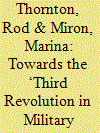| Srl | Item |
| 1 |
ID:
190104


|
|
|
|
|
| Summary/Abstract |
The United Kingdom’s homeland resilience capacity is poor. The COVID-19 pandemic proved this. Back in 2019, the UK had been labeled as the best prepared country in the world for a pandemic. And yet, by 2020, and once COVID-19 had struck, the UK became “unequivocally” the hardest hit country in Europe – particularly in terms of excess mortality. In this article it is argued that the UK’s continental neighbors coped better than the UK because they had better homeland resilience capacity. This was provided by their having civil defense organizations, paramilitary forces and militaries which are specifically designed to contribute to homeland emergencies. The UK, in contrast and almost uniquely in the world, lacks both civil defense and paramilitary bodies and, moreover, it has armed forces that are not actually structured to provide help in domestic emergencies. Given the problems highlighted during COVID-19, is it now time for the UK to set up its own bodies specifically tasked with alleviating domestic emergencies? This article explores this question by comparing the UK’s pandemic response with that of Spain – a country which, according to all available data, should have performed worse than the UK. But it did not. Why?
|
|
|
|
|
|
|
|
|
|
|
|
|
|
|
|
| 2 |
ID:
173828


|
|
|
|
|
| Summary/Abstract |
This article examines the strategies employed – or not employed – in the Peruvian counterinsurgency campaign against the Sendero Luminoso insurgent group. Using Carl von Clausewitz’s and Colin Gray’s strategic theories as a lens through which to analyze the conflict, the aim here is to show what role strategy played in the eventual defeat of this insurgency and what obstacles the Peruvian state and its armed forces faced in enacting good strategy. Specifically, the utilization of the ‘strategy bridge’ concept is investigated. For a large part of this conflict, the strategy bridge linking the civil authorities with the military and its activities was missing. Once there emerged a clear understanding of the importance of ends, ways and means working in harmony could an effective counterinsurgency campaign flourish.
|
|
|
|
|
|
|
|
|
|
|
|
|
|
|
|
| 3 |
ID:
174496


|
|
|
|
|
| Summary/Abstract |
There is an ongoing international arms race in the field of artificial intelligence (AI). But whereas military organisations in the West are viewing AI principally as an enabler in the tactical realm, this is not the case in Russia. The Russian military sees AI’s greatest utility at the strategic level. Its emphasis is on employing AI-enhanced information warfare tools (including in cyber warfare) to produce truly game-changing strategic effects against state adversaries. AI’s use in this capacity heralds a ‘third revolution in military affairs’. Rod Thornton and Marina Miron examine its profound implications for the future of warfare
|
|
|
|
|
|
|
|
|
|
|
|
|
|
|
|